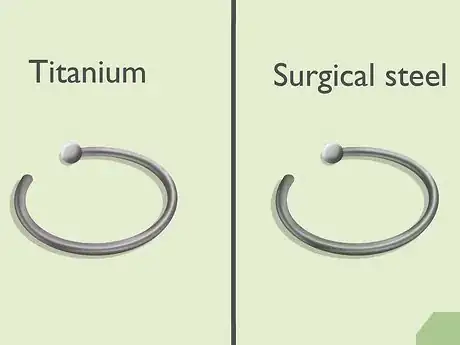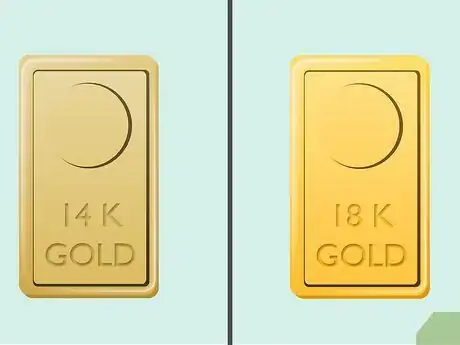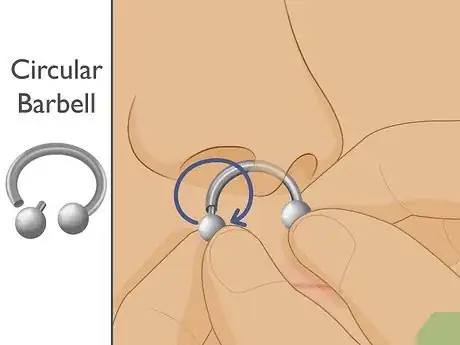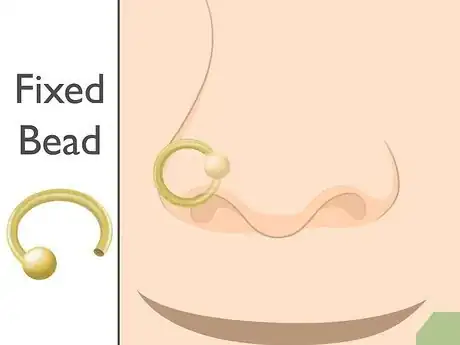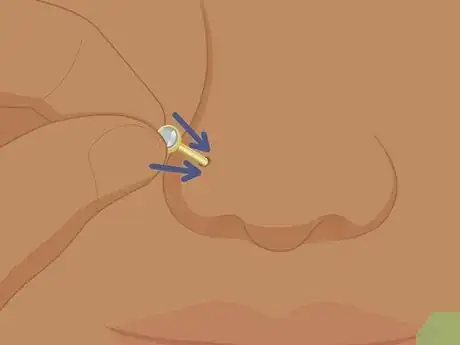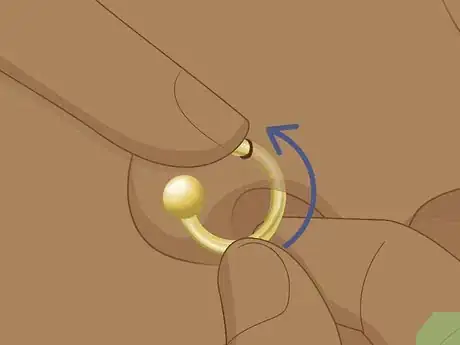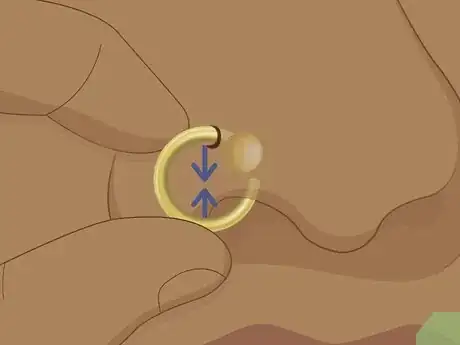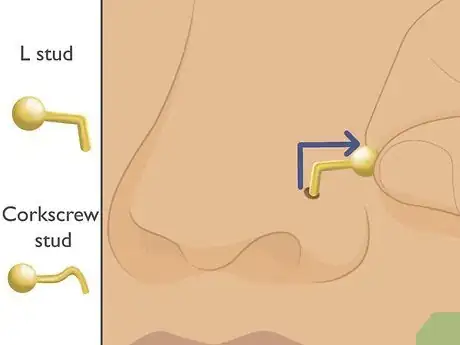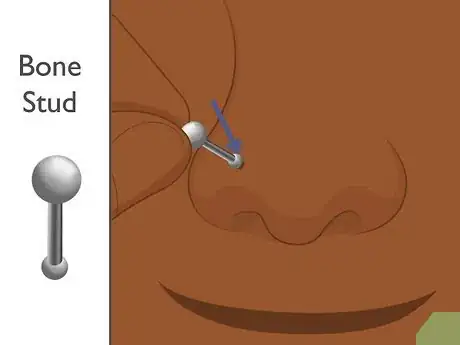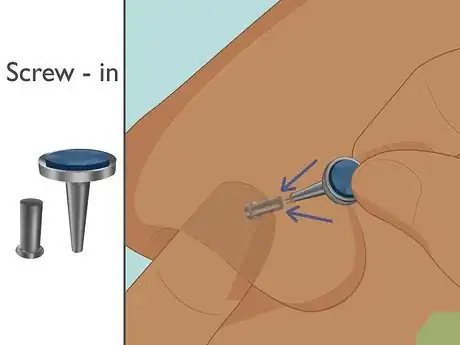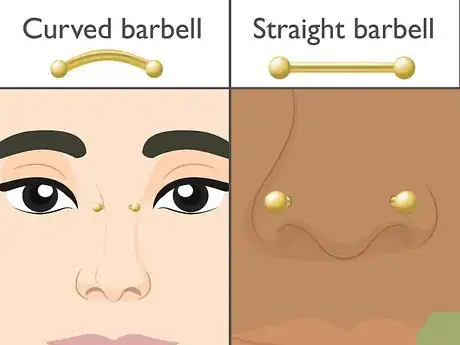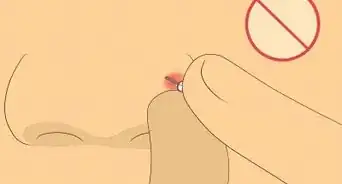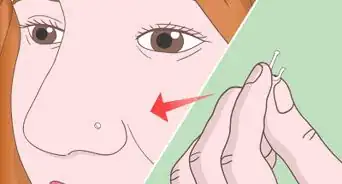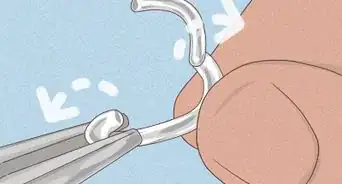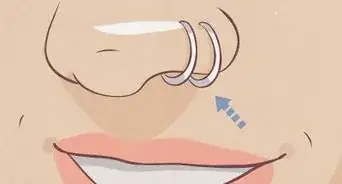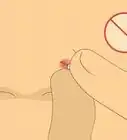This article was co-authored by Karissa Sanford. Karissa Sanford is the Co-owner of Make Me Holey Body Piercing, a piercing studio based in the San Francisco Bay Area that specializes in safe and friendly body piercing. Karissa has over 10 years of piercing experience and is a member of the Association of Professional Piercers (APP).
There are 12 references cited in this article, which can be found at the bottom of the page.
This article has been viewed 40,171 times.
A nose ring can add a little pizzazz to your nose piercing. It will typically stay in place well, but it can be a little difficult to get in your nostril, as you're trying to push a rounded piece of metal into a straight piercing. It helps to choose the best ring for your nose based on the metal and gauge so that you're not trying to push a ring into your nose that's too large.
Steps
Picking a Nose Hoop
-
1Pick titanium or surgical steel if you are sensitive to metals. Surgical steel is cheap, and many people can wear it without difficulty. However, if you have a nickel sensitivity, switch to titanium, which is nickel-free. Titanium comes in a variety of colors and is lightweight, meaning it won't weigh down your piercing.[1]
- Niobium can also be a good option, but it isn't as regulated as titanium. With titanium, you can find implant grades that are ASTM F-136 compliant, ISO 5832-3 compliant, or ASTM F-67 compliant, which indicate they are high quality enough for body jewelry.
-
2Opt for 14K to 18K if you want gold. Check to make sure it's nickel-free. It must be above 14K for an initial piercing, though it can be lower once your piercing has healed. However, don't go above 18K, as the metal will be too soft and susceptible to nicks.[2]
- Platinum is also an option for nose piercings, but it tends to be very expensive.
Advertisement -
3Ensure you're getting the proper gauge. The gauge is the size of the wire. A higher number means a smaller sized wire, the opposite of what you'd typically think. So a 22-gauge ring is smaller than a 20-gauge ring. Pick one that's the same size, smaller, or no more than one gauge bigger than the one you're already wearing so that you won't hurt your nose trying to get the ring in.[3]
- Choose size based on aesthetics, as well. A smaller gauge looks more delicate, while a larger gauge makes more of a statement.
- Hoops create more movement than studs, so you should make sure your piercing is healthy and stable before switching to a piece of jewelry that's going to move more.
-
4Pick a circular barbell for septum piercings. A circular barbell is a hoop with a chunk taken out of one side. It has a ball on each end to hold the jewelry in place. This works best for septum piercings because it's easy to insert, and the beads on either end keep it from sliding out.[4]
- To put one in, unscrew the bead at one end and stick the hoop through the piercing. Screw the bead back into place. Always remember "righty-tighty, lefty-loosey," meaning you unscrew to the left and tighten to the right.
-
5Opt for a fixed bead ring for a nostril piercing. This type of ring is a complete hoop, but you can pull it apart to make a space. One side will have a bead on it to hold it in place. This works well for a standard nose piercing.
- No part of this hoop unscrews.
Putting a Nose Hoop in Your Nostril
-
1Wash your hands, nose, and the jewelry first. Scrub your hands with warm water and soap for at least 20 seconds before rinsing. Wipe off your nose with saline solution on a paper towel or a saline wipe. Clean the nose ring with a saline wipe after removing the bead if yours has one.[5]
- You can also soak the ring in saline for a few minutes.
-
2Open up a tight hole with a stud before inserting the ring. If you haven't worn a nose ring or stud in awhile, push a stud earring or nose stud through the hole first. That will help open up the hole, making it easier to put in your nose ring.[6]
-
3Begin from the inside of your nostril with the non-beaded side. Open the earring up by gently pulling it apart. Place the non-beaded side on the inside of your nose and find the hole. Use your fingers to guide you as needed. Push the hoop through the hole so it comes through on the outside. Look in a mirror to tell when the hoop comes out or use your finger to judge.[7]
- Sometimes it helps to guide the ring by sticking a stud in through the outside. It can help you find the hole and push the hoop through.
- Be patient! When you get a piercing, the piercer uses a straight needle to do it. A curved hoop is hard to get in sometimes.[8]
-
4Set the hoop in place by twisting the ball to the inside. Turn the hoop until the ball rests against the hole on the inside of your nose. Gently push the hoop back together by squeezing both sides so that the end without a bead meets the other side.[9]
Trying Other Nose Jewelry
-
1Opt for an L-shaped stud or corkscrew for easy removal. If you need to take your nose stud in and out often, this shape is likely the easiest to remove. Simply catch the edge with your fingernail and tip it out of your nose. Make sure to remove it over a towel in case it falls out.[10]
- A corkscrew is a similar design, but it will stay in place better because of the way it loops around inside your nose.
- If an L-shaped stud is too long for the width of your nostril, you can usually use pliers to adjust it so it's shorter. Many L-shaped studs have measurements for the width of your nostril in millimeters, so you can also use a ruler to measure how wide your skin is. If it's too long, it will keep running into your nose cavity, which can be painful.
-
2Pick a bone stud for the lightest secure option. A bone stud has a small ball on the end of the stud. This ball will help hold the stud in place in your nostril. The main drawback is you need to push that ball through your piercing hole to get the stud in place, which can be painful at first.[11]
- A bone stud works well because you can usually feel it pulling out of your nose during the day so you can push it back in place.
- You can get a straight stud without a ball, called a nose pin. This kind won't stay in place as well, though.[12]
-
3Choose a screw-in version for the most security. These pieces have a small flat piece that screws into the back of the stud. The main issue with these is they can be difficult to screw in. Once they're in place, though, the stud will stay in as long as the screw is tight.
- To screw one in, you have to insert the stud then hold the flat piece up to the stud on the inside. You usually can only get one finger in to hold it in place.
-
4Try barbells for piercings along your bridge or across your nostrils. Barbells have screw-in balls on either end. Some are straight across, while others are curved. The curved version works well across your bridge, as the curve can make it easier to put in; take one side off and push the barbell through both sides of the piercing. Screw the ball back in place on the other side.[13]
- A straight barbell works the same way, and you can use it across your nostrils.
- Typically, the piercer will use a curved barbell on the bridge of the nose to keep it from migrating out of the skin. If you weren't pierced with a curved piece, it will be difficult to put one in, and you may need to use a straight one.
References
- ↑ https://safepiercing.org/jewelry-for-initial-piercings/
- ↑ https://safepiercing.org/jewelry-for-initial-piercings/
- ↑ https://www.wildtattooart.com/nose-piercing
- ↑ https://www.wildtattooart.com/nose-piercing
- ↑ https://authoritytattoo.com/how-to-put-in-a-hoop-nose-ring/
- ↑ https://www.youtube.com/watch?v=IjzzfkplKcE&t=22
- ↑ https://www.youtube.com/watch?v=IjzzfkplKcE&t=49
- ↑ https://www.youtube.com/watch?v=Ngqvj6-PsDc&t=219
- ↑ https://www.youtube.com/watch?v=IjzzfkplKcE&t=114
- ↑ https://www.wildtattooart.com/nose-piercing
- ↑ https://www.youtube.com/watch?v=Ngqvj6-PsDc&t=87
- ↑ https://fupping.com/harry/2019/08/21/a-guide-to-the-different-types-of-nose-piercings-standard-piercing-sizes/
- ↑ https://www.wildtattooart.com/nose-piercing
- ↑ https://www.inc.com/alison-green/how-to-tell-an-employee-no-nose-rings.html
